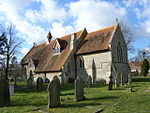Rocket Propulsion Establishment
1946 establishments in EnglandAylesbury ValeGrade II* listed buildings in BuckinghamshireGrade II listed buildings in BuckinghamshireMilitary research establishments of the United Kingdom ... and 5 more
Research institutes in BuckinghamshireRocket engine manufacturers of the United KingdomRocketrySpace programme of the United KingdomUse British English from March 2015

The Rocket Propulsion Establishment at Westcott, Buckinghamshire on the site of the former RAF Westcott has made a number of notable contributions in the field of rocket propulsion, including input on the rocket design for the Blue Streak missile and the propulsion systems on Chevaline. It was also known as the Guided Projectiles Establishment and PERME Westcott (Propellants, Explosives and Rocket Motor Establishment, Westcott). For many years this establishment was regarded as so secret that it was not marked on Ordnance Survey maps, although it was present, from necessity, on maps for the use of pilots.
Excerpt from the Wikipedia article Rocket Propulsion Establishment (License: CC BY-SA 3.0, Authors, Images).Rocket Propulsion Establishment
Geographical coordinates (GPS) Address Nearby Places Show on map
Geographical coordinates (GPS)
| Latitude | Longitude |
|---|---|
| N 51.842 ° | E -0.975 ° |
Address
Westcott Venture Park
England, United Kingdom
Open on Google Maps






